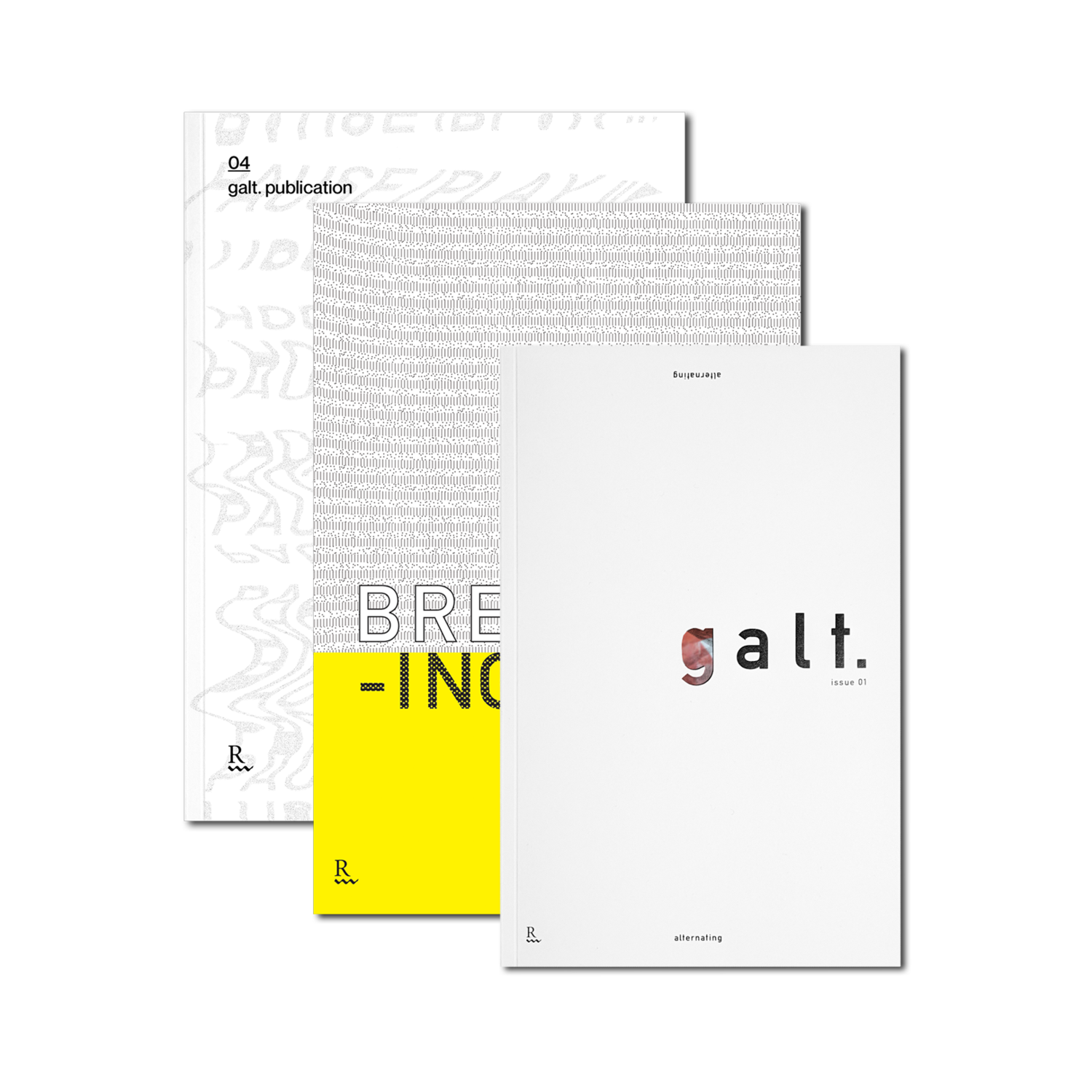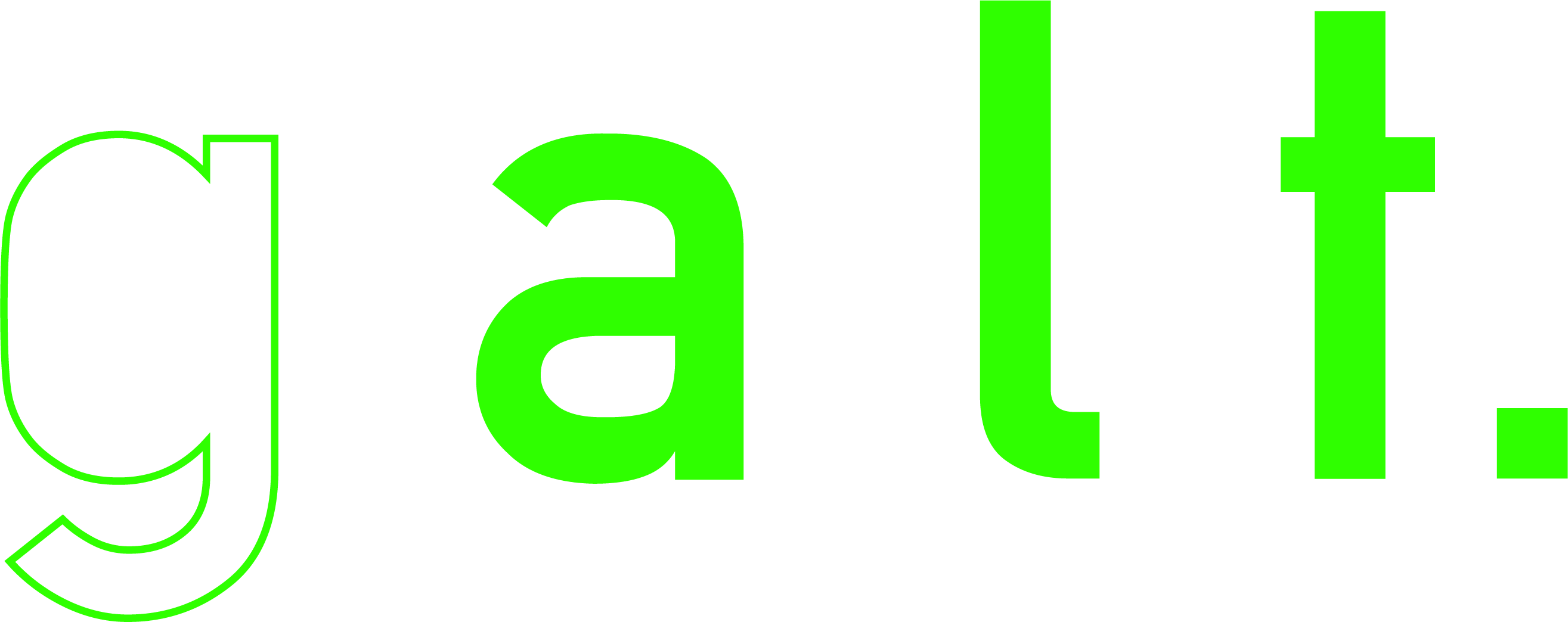05 — TBD
Seeds
In this issue we rewind and reimagine – reflecting on our past and planting seeds for our futures. galt.issue 05 is about growth, adaptation, and evolution. It is about looking at the beginnings of things and how they can develop with the right care. Standing on uncertain ground, let us uncover the seeds that have and haven’t been sown.
TBD
04 — 2021
Pause / Play
$30
$30
Our reality has shifted. Through sporadic lockdowns, movements for social change shake the world while we organize within the digital realm. As time becomes nebulous, galt’s fourth issue addresses the designer’s role within our current reality and critically addresses the design of better ones. Building on Waterloo Architecture's What is Solidarity? Speaker Series, this issue features conversations with Vivien Sansour, Joel Sanders and Susan Stryker, Amy Smoke, and Syrus Marcus Ware to examine pausing and playing within design practices.
On pause: As neoliberal frameworks perpetuate social inequality and the planet burns, we look to other ways of knowing to inform our realities. In pausing, we examine settler relationships to land on Turtle Island, the importance of knowing oneself, the limits of productivity and the profession, exclusivity in architectural representation, and the lasting spatial effects of the COVID-19 pandemic.
On play: As designers of the built environment, our imagination is our strength, and we tease it into existence. Here, we examine inequity within our academic institutions, land occupation and protest strategies, the meaning of care as a practice, the designer’s role in museum restitution, and the design and experience of alternate worlds we’d like to see realized. This is our play space. What could our reality look like, and where will we go from here?
We invite you to pause, and we hope to move forward in a better way.
On pause: As neoliberal frameworks perpetuate social inequality and the planet burns, we look to other ways of knowing to inform our realities. In pausing, we examine settler relationships to land on Turtle Island, the importance of knowing oneself, the limits of productivity and the profession, exclusivity in architectural representation, and the lasting spatial effects of the COVID-19 pandemic.
On play: As designers of the built environment, our imagination is our strength, and we tease it into existence. Here, we examine inequity within our academic institutions, land occupation and protest strategies, the meaning of care as a practice, the designer’s role in museum restitution, and the design and experience of alternate worlds we’d like to see realized. This is our play space. What could our reality look like, and where will we go from here?
We invite you to pause, and we hope to move forward in a better way.
ISSUE TEAM
Natalie Jianyi Kopp
Lucy Lin
Nisha Bhathella
Sigi Buzi
Vicky Cao
Jamie Cheung
Tobias Feltman
Magdalena Kaczmarczyk
Isabel Kim
Ellie Kingsley
Cathy Li
Omar Oosthuizen
Mayuri Paranthahan
Poorna Patange
Ali Sermol
Brian Tien
Cynthia Zhang
Daisy Zhang
Natalie Jianyi Kopp
Lucy Lin
Nisha Bhathella
Sigi Buzi
Vicky Cao
Jamie Cheung
Tobias Feltman
Magdalena Kaczmarczyk
Isabel Kim
Ellie Kingsley
Cathy Li
Omar Oosthuizen
Mayuri Paranthahan
Poorna Patange
Ali Sermol
Brian Tien
Cynthia Zhang
Daisy Zhang

03 — 2020
Burning
Issue three of galt. positions the design profession as an agent of social and climatic change while its accompaniment here & now dissects and addresses its systemic complacency. Joshua Wallace imagines a glacier accordion whose melody morphs as it melts; Emily Guo plans the conversion of a defunct and contaminated military base into a wildlife refuge; Hiba Zubairi investigates the black market “water gangs” of Lahore, Pakistan; and in a comic by Brendan Lacy, an astronaut takes us on stroll through the multiverse of worldviews. These projects sit among twelve other narratives and are presented alongside eight original interviews—including features from Kiel Moe, Urbonas Studio, and Ange Loft—that prioritize social and environmental resilience in our cities.
You can view a free digital copy of Issue 03: Burning + here & now on galt’s Issuu account.
ISSUE TEAM
Zaven Titizian
Annika Babra
Caroline Brodeur
Kate Brownlie
Vicky Cao
Anya Chuprys
Jamie Cheung
James Clarke-Hicks
Kelsey Dawson
Jacob Dimla
Iryna Humenyuk
Andrew Kenny
Maddy Kim
Elizabeth Lenny
Cathy Li
Jade Manbodh
Chi Chi Ogbu
Hyunjoo Park
Logan Steele
Anna Supryka
Zaven Titizian
Annika Babra
Caroline Brodeur
Kate Brownlie
Vicky Cao
Anya Chuprys
Jamie Cheung
James Clarke-Hicks
Kelsey Dawson
Jacob Dimla
Iryna Humenyuk
Andrew Kenny
Maddy Kim
Elizabeth Lenny
Cathy Li
Jade Manbodh
Chi Chi Ogbu
Hyunjoo Park
Logan Steele
Anna Supryka
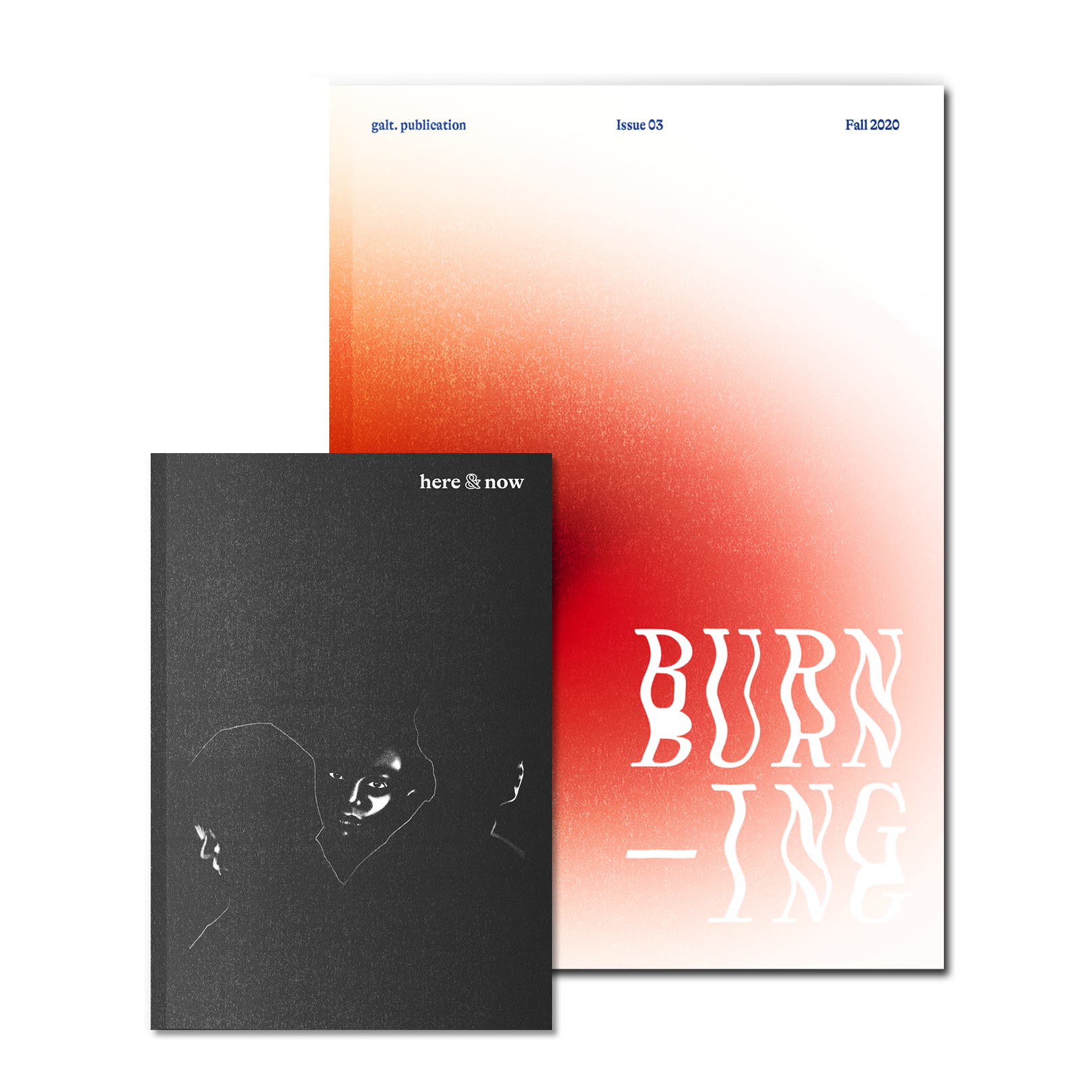
02 — 2019
Breaking
$5
$5
From breaking ground to ‘breaking the box’, designers love to take things apart and play with the pieces. We rely on taxonomies and rules of thumb to help us understand underlying logics. Work is often judged by its ability to be systematically disseminated to other architects. We understand design through exploded diagrams and 1:1 detail models. Projects are broken down by component, by program, by typology.
The design process can also involve a different sort of breaking: deviating from the norm and questioning the boundaries of architecture. Designers such as Sean Lally and Malkit Shoshan ‘break the box’ through a multitude of media: responsive environments, cross-disciplinary advocacy, advanced computational methods, and prototyping novel ways to inhabit space. ‘Breaking architecture’ is also defined by transgression. Bypassing exterior facades and engaging with the interior enables us to enter a realm in which users have more control over the built environment than architects. Although as-built conditions impose spatial order, inhabitants find ways to subvert spaces to reflect their ideals.
The design process can also involve a different sort of breaking: deviating from the norm and questioning the boundaries of architecture. Designers such as Sean Lally and Malkit Shoshan ‘break the box’ through a multitude of media: responsive environments, cross-disciplinary advocacy, advanced computational methods, and prototyping novel ways to inhabit space. ‘Breaking architecture’ is also defined by transgression. Bypassing exterior facades and engaging with the interior enables us to enter a realm in which users have more control over the built environment than architects. Although as-built conditions impose spatial order, inhabitants find ways to subvert spaces to reflect their ideals.
ISSUE TEAM
Daniel Beg
Jamie Cheung
Jonas Chin
Elise Cloutier
Maighdlyn Hadley
Cian Hrabi
Magnus Glennie
Natalie Kopp
Jessica Lam
Kobi Logendrarajah
Shanne Stines
Anna Supryka
Elaine Tat
Victor Tulceanu
Callan Wilson
Daniel Beg
Jamie Cheung
Jonas Chin
Elise Cloutier
Maighdlyn Hadley
Cian Hrabi
Magnus Glennie
Natalie Kopp
Jessica Lam
Kobi Logendrarajah
Shanne Stines
Anna Supryka
Elaine Tat
Victor Tulceanu
Callan Wilson
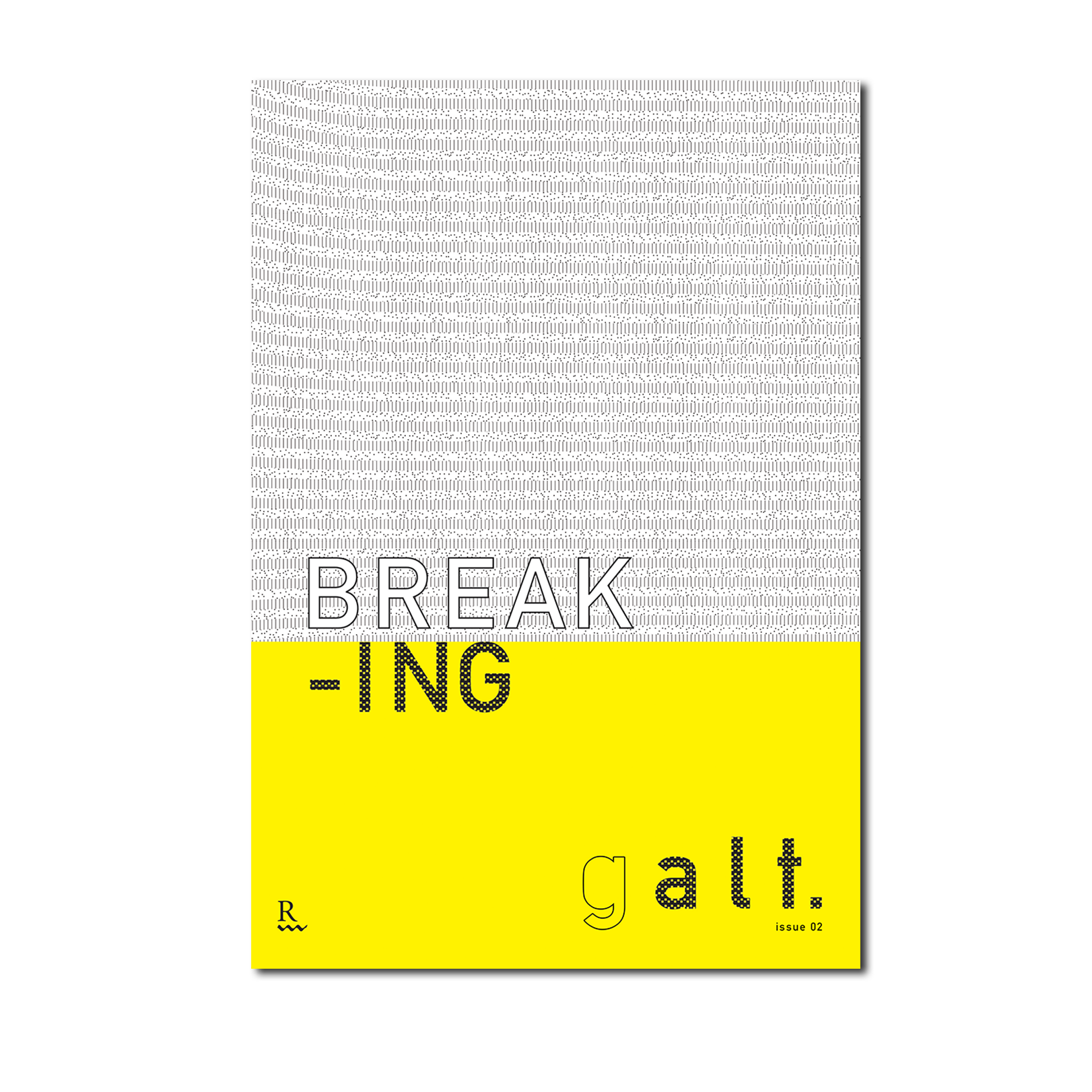
01 — 2018
Alternating
$10
$10
Designing is making conscious decisions through which we, as architects, navigate infinite possibilities. By curating these possibilities, we create reactionary forces between alternates, constantly straddling the multi-faceted existence of any subject, object, or idea. Designing is iterating between possibilities, consciously affixing decisions, creating tension between alternates.
Alternating is a constant state of succession. The historical symbols of Neoclassicism propelled the reinventions in Modernism, and contesting these transformations brought about Postmodernism. This momentum of alternating, generated our current line of questioning in design. The cycle of criticizing the established creates constant renewal. The identity of UWSA is fostered through this culture of questioning, of constantly iterating and alternating.
Galt sets out to describe—through a tapestry of student, faculty and alumni work—the approach to architecture that the University of Waterloo School of Architecture has created.
Alternating is a constant state of succession. The historical symbols of Neoclassicism propelled the reinventions in Modernism, and contesting these transformations brought about Postmodernism. This momentum of alternating, generated our current line of questioning in design. The cycle of criticizing the established creates constant renewal. The identity of UWSA is fostered through this culture of questioning, of constantly iterating and alternating.
Galt sets out to describe—through a tapestry of student, faculty and alumni work—the approach to architecture that the University of Waterloo School of Architecture has created.
ISSUE TEAM
Jonas Chin
Daniel Abad
Michelle Bullough
Ammar Ghazal
Iryna Humenyuk
Natalie Kopp
Alex Martin
Victoria Ngai
Alexandra Siu
Johnathan Subendran
Morgan Wright
Emmeily Zhang
Liyang Zhang
Jonas Chin
Daniel Abad
Michelle Bullough
Ammar Ghazal
Iryna Humenyuk
Natalie Kopp
Alex Martin
Victoria Ngai
Alexandra Siu
Johnathan Subendran
Morgan Wright
Emmeily Zhang
Liyang Zhang
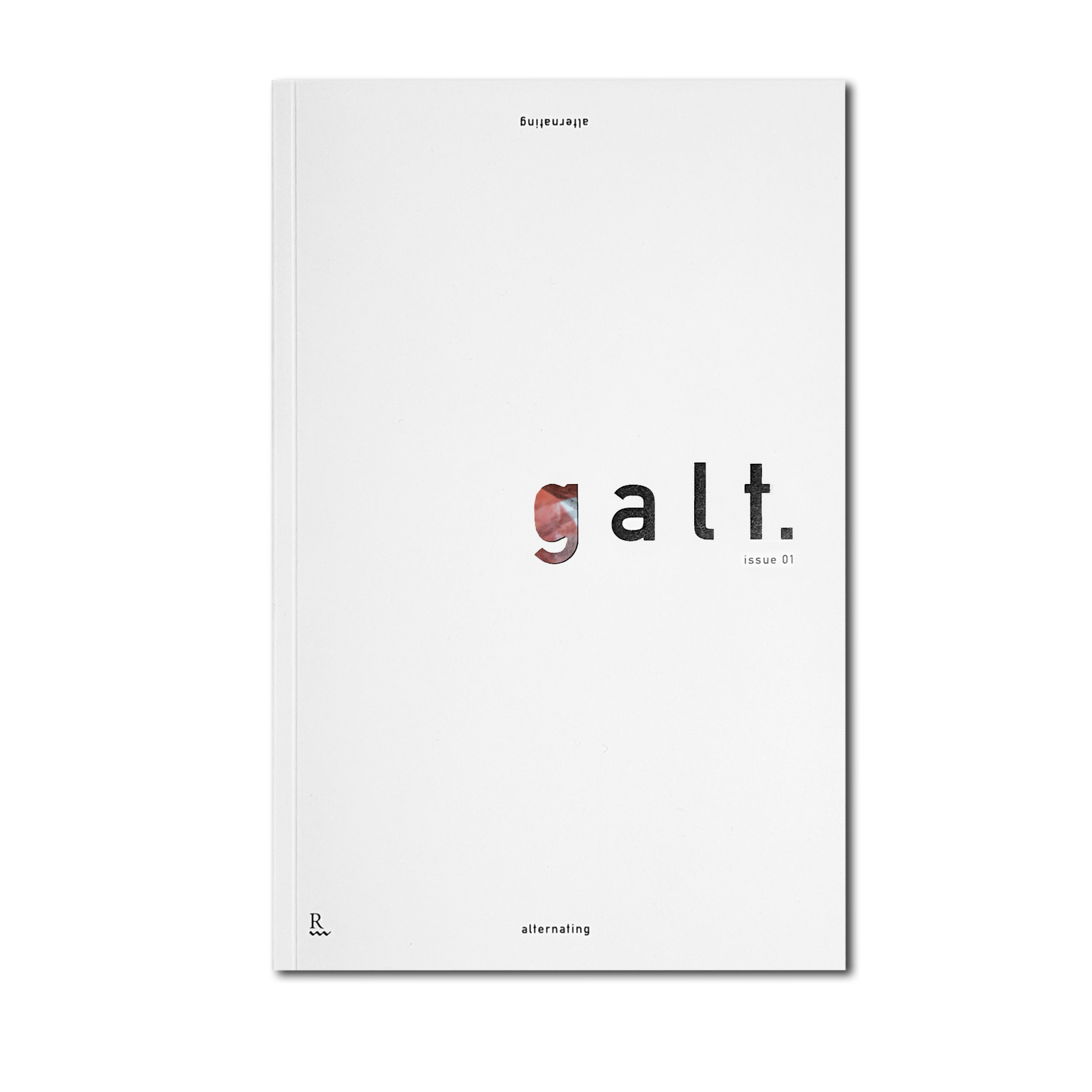
0.01 — 2021
Issue 1 + 2 + 4 Bundle
$40
$40
We still have copies left! Order Issue 01 & Issue 02 together with Issue 04 and save!
